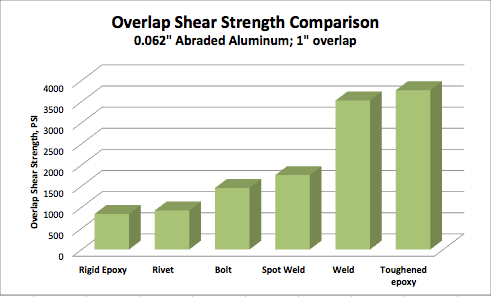Senior Technical Service Specialist – Industrial Adhesives and Tapes
- FMA
- The Fabricator
- FABTECH
- Canadian Metalworking
Categories
- Additive Manufacturing
- Aluminum Welding
- Arc Welding
- Assembly and Joining
- Automation and Robotics
- Bending and Forming
- Consumables
- Cutting and Weld Prep
- Electric Vehicles
- En Español
- Finishing
- Hydroforming
- Laser Cutting
- Laser Welding
- Machining
- Manufacturing Software
- Materials Handling
- Metals/Materials
- Oxyfuel Cutting
- Plasma Cutting
- Power Tools
- Punching and Other Holemaking
- Roll Forming
- Safety
- Sawing
- Shearing
- Shop Management
- Testing and Measuring
- Tube and Pipe Fabrication
- Tube and Pipe Production
- Waterjet Cutting
Industry Directory
Webcasts
Podcasts
FAB 40
Advertise
Subscribe
Account Login
Search
Adhesives and bonding tapes: Enhancing design space
- By Shari Loushin
- June 29, 2016
- Article
- Assembly and Joining
For many years fabricators have relied on tried-and-true methods like welding and mechanical fasteners to bond and fasten materials to create durable assemblies. These methods, while solid and effective, are not the only ways to join materials.
An emerging addition to a fabricator’s arsenal of joining methods is bonding with adhesives and tapes. These materials can deliver excellent durability and aesthetic value, while expanding the range of materials that can be used.
Challenges in Design
As design trends evolve, more fabricators are looking to use more lightweight and versatile metals, like stainless, carbon steel, and aluminum. These materials can provide unique attributes to the end product but are often difficult to join with traditional methods such as welding or mechanical fasteners.
In some cases, traditional methods can damage these materials. Welding is not always practical, as it can cause heat distortion or burn through thin-gauge metal.
Mechanical fasteners, like rivets and bolts, risk tearing or weakening the bond because all of the load-bearing stress is concentrated at the fastening point. Secondary sealing might be required to prevent leakage, which ultimately can reduce the product’s quality and lifespan.
Some projects require a smooth and polished finish. For these applications, it can be challenging to disguise rivets without additional features that can rack up part costs and lower productivity. If weld marks are not desirable on a certain product, removing these marks can require costly and time-consuming labor operations.
Adhesive and Bonding Tape
Adhesives and bonding tapes can address the challenges traditional joining methods present when alternative substrates are needed in assembly. For many applications, adhesives and bonding tapes help improve fabrication lead times and can provide an edge for fabricators looking to diferentiate themselves from their competition.
Because no heat is needed, using certain adhesives or bonding tapes prevents damage to heat-sensitive or lightweight metals. When used with fragile materials, these easy-to-apply products avoid puncturing or damaging the substrate.
Using adhesives and bonding tapes also can increase the bond quality by distributing the load-bearing stress throughout the entire surface area of the substrate. This is especially important for thinner substrates that are more susceptible to damage and fatigue failure when all of the stress is focused at one point.
Unfortunately, some metals are oily and have chemical compositions that render them intrinsically difficult to bond, even with adhesives and bonding tapes. If a substrate is oily or has a low surface energy, fabricators can turn to their providers to determine if a specialty adhesive or tape exists that fits their specific application needs.
With a virtually invisible bond, adhesives and bonding tapes provide a seamless look, which can improve part appearance with less labor.
In addition to bonding ability and aesthetic quality, adhesives are cost- and time-effective. The speed and simplicity of application eliminates excess steps and reduces equipment requirements.
Adhesives and Bonding Tapes in Action
Despite the benefits adhesives and bonding tapes offer, some fabricators doubt their strength capabilities for large-scale design projects.
However, there are viable options for any type of project:
- Specialty structural adhesives have been shown to exceed weld strength on thinner-gauge metals.
- Adhesive sealants have high elongation, are flexible, and provide excellent gap filling in panel-to-frame assembly.
- Toughened epoxies offer impact resistance and strength for challenging applications in automotive, aerospace, sporting goods, and other industries.
- Spray adhesives provide excellent strength and are very cost-effective for large laminations.
- Flexible and strong acrylic foam tapes are suitable for bonding dissimilar substrates and for mounting panels for glazing and curtain walls.
These are just some examples of the limitless types of adhesives and tapes available for all kinds of assembly that fabricators encounter in the shop every day.
Fabricators are in business to provide the best product possible for their customers. Adhesives and bonding tapes could help expand theri product offerings and business.
About the Author
Shari Loushin
3M Center, 220-5E-06
St. Paul, MN 55144
1-800-362-3550
subscribe now

The Fabricator is North America's leading magazine for the metal forming and fabricating industry. The magazine delivers the news, technical articles, and case histories that enable fabricators to do their jobs more efficiently. The Fabricator has served the industry since 1970.
start your free subscription- Stay connected from anywhere

Easily access valuable industry resources now with full access to the digital edition of The Fabricator.

Easily access valuable industry resources now with full access to the digital edition of The Welder.

Easily access valuable industry resources now with full access to the digital edition of The Tube and Pipe Journal.
- Podcasting
- Podcast:
- The Fabricator Podcast
- Published:
- 04/16/2024
- Running Time:
- 63:29
In this episode of The Fabricator Podcast, Caleb Chamberlain, co-founder and CEO of OSH Cut, discusses his company’s...
- Industry Events
16th Annual Safety Conference
- April 30 - May 1, 2024
- Elgin,
Pipe and Tube Conference
- May 21 - 22, 2024
- Omaha, NE
World-Class Roll Forming Workshop
- June 5 - 6, 2024
- Louisville, KY
Advanced Laser Application Workshop
- June 25 - 27, 2024
- Novi, MI
































